The wall never changes.
No matter the competition, the field of play for New Zealand speed climber Sarah Tetzlaff remains the same: a standardised 15-metre high wall, with a five-degree overhang.
The red, five-pointed hand holds that snake their way up the wall are always positioned in the same spot, fixed at the same angle. So, too, the narrow footholds that barely seem large enough to accommodate a big toe.
At Climbing NZ's indoor training venue in Mount Maunganui, Tetzlaff - one half of New Zealand's pioneering speed climbing duo that will make their debut in Paris next month - dips her hands into her chalk bag and takes her place on the touch pad at the base of the wall.
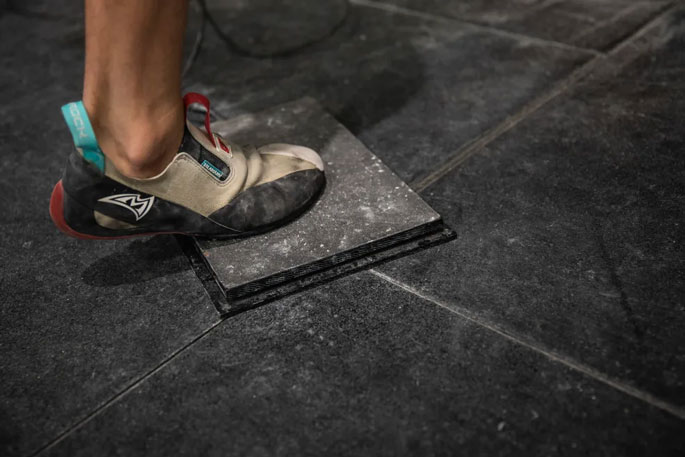 The starting position. Photo: RNZ / Cole Eastham-Farrelly.
The starting position. Photo: RNZ / Cole Eastham-Farrelly.
She then stretches her body out like a slingshot ready to catapult herself to the top of the wall, as she grips the first handhold above her tightly with both hands. Her left foot sits on the first foothold, the right stays in contact with the touch pad.
Three loud beeps count Tetzlaff down, before the buzzer sounds and she explodes up the wall, lightly pouncing from hold to hold. Within seconds she is slamming the pad at the top to stop the clock.
It takes the top male climbers in the world less than five seconds to clamber up the wall, while the women's world record sits at a shade over six seconds, making speed climbing the fastest Olympic sport.
Doing this in training is one thing. But the event format - in which climbers are pitted head-to-head in a vertical sprint - adds to the high octane, high stress nature of the sport.
Tetzlaff has a more zen view.
She finds a sense of calm in the familiar constellation of 20 handholds and 11 footholds that span the wall.
"I think because the wall is always the same, you can control the stresses," Tetzlaff, who will be New Zealand's first Olympic speed climbing representative alongside Julian David, says.
"You can get into this really nice flow state that you don't feel in the rest of your life, and it's just a feeling that you chase."
And so she chases that feeling over and over again. The repetition is the addictive element, she says.
 New Zealand Olympian Sarah Tetzlaff. Photo: RNZ / Cole Eastham-Farrelly.
New Zealand Olympian Sarah Tetzlaff. Photo: RNZ / Cole Eastham-Farrelly.
After each run, Tetzlaff consults with her coach, Rob Moore, who has an iPad trained on the wall.
Together they huddle around the screen, breaking the run down move-by-move to see where improvements can be made. With so little time on the wall, there is no room for error. It is a sport that rewards attention to detail.
"I'm definitely a bit of a perfectionist. So it works really well with how my brain ticks," Tetzlaff, who is studying towards a masters in environmental science, says.
"It's little micro-movements and micro-adjustments that can either keep you on the wall or throw you off the wall.
"So like the angles of my knees, of my hips, of my wrists - even down to something as simple as your finger hitting the hold wrong - it all contributes to either a really good run or something that can be quite average, like 0.2 seconds slower."
While Tetzlaff prepares for her next run, Moore explains that each climber's method - or what they call their "beta" - is different. How an athlete tackles the wall depends on their physiology.
"Even though the wall is exactly the same, they will use different holds and have different methods to getting through sections, depending on their height or their amount of pop or strength, so one of the big things is always trying to work out what each athlete can do on the wall."
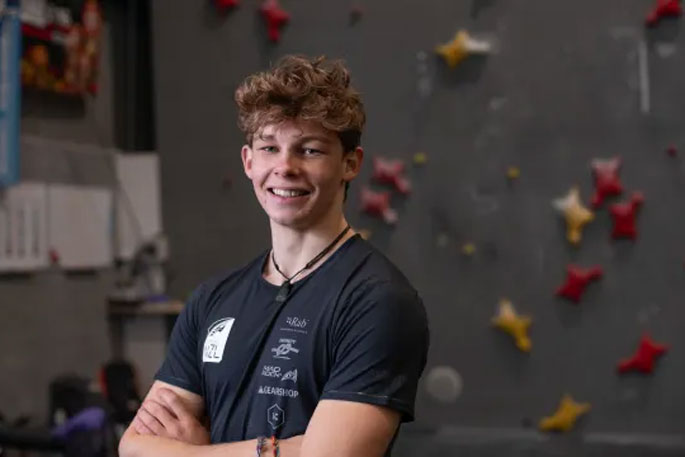 Olympic speed climber Julian David. Photo: RNZ / Cole Eastham-Farrelly.
Olympic speed climber Julian David. Photo: RNZ / Cole Eastham-Farrelly.
He says climbers develop new approaches over time. A year ago, for example, Julian David won the junior world championships using a different beta to the one he will run at the Games in just over a week.
The wall never changes. But there are many pathways to the top.
Selling the dream
Moore loves to make a statement.
His whole look - he sports a mohawk-mullet hybrid hairdo that competes for attention with orange spectacles - is a statement in self-expression.
When the International Climbing Federation announced that it would create a separate speed climbing event for the Paris Olympic Games, Moore made a huge statement in resigning as head coach of Climbing NZ.
Sport climbing made its splashy Olympic debut in 2021 at the Tokyo Games. There, climbers competed in a unique format combining three disciplines - boulder, lead and speed climbing - for a single medal event.
Within the sport, the format proved controversial. Bouldering and lead are more aerobic disciplines in which the emphasis is on problem solving, requiring a very different skillset to that required for an explosive five-second vertical scramble. As one athlete described it, "it's like asking Novak Djokovic to play table tennis for the opening set".
But the innovative format succeeded in packaging up the essential elements of the sport to create a highly watchable event for billions around the world.
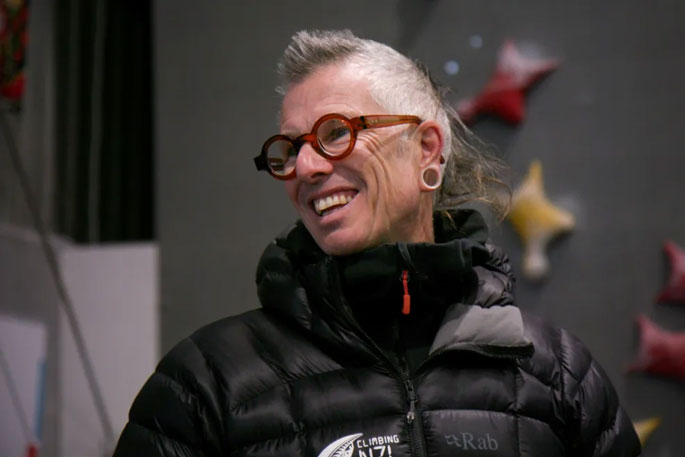 Coach Rob Moore. Photo: RNZ / Cole Eastham-Farrelly.
Coach Rob Moore. Photo: RNZ / Cole Eastham-Farrelly.
After the event's successful debut, the International Olympic Committee allocated climbing an additional medal for the Paris Games, allowing the world governing body to split off the bouldering and lead from the speed climbing event.
Moore saw in this a golden (or silver, or bronze) opportunity.
"As soon as that happened, I thought 'we have a speed climbing wall here, we have all the infrastructure and facilities to run a really good programme'," he says.
"So I resigned as head coach of Climbing NZ and said 'I wanna run this programme - I've written it all up and I know how we can make it work'."
As climbing has morphed from purely an adventure sport to one that is condensed, codified and scored for elite competition, the challenge for the sport's leaders has been to develop structures that support a high-performance programme.
Moore says he learned a lot from earlier attempts to establish formal pathways.
"Climbing, like skateboarding and surfing and those sort of sports, comes from a pretty laid-back sort of culture, so it is hard to establish a high performance programme where athletes want to be really dedicated to the competition side of it, because there's so much enjoyment in the hobby side of it as well," he says.
"So part of the challenge for me was finding athletes who were like 'ok, I love the hobby side of it but I really do want to see if I can explore being better at the competitive side of it'."
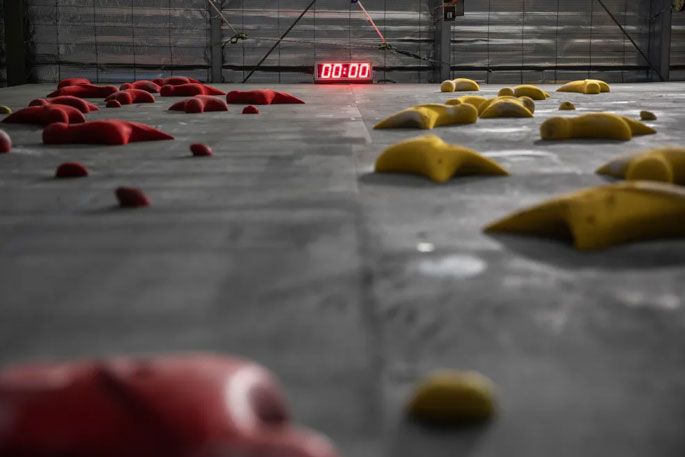 The view from the touchpad at the bottom of the wall. Photo: RNZ / Cole Eastham-Farrelly.
The view from the touchpad at the bottom of the wall. Photo: RNZ / Cole Eastham-Farrelly.
Moore already had a dedicated student of the sport in Tetzlaff.
After unexpectedly qualifying for the 2018 Youth Olympics, the Wellingtonian made the move to Mount Maunganui the day after her final NCEA exam to commit herself to training for the event.
Back then, David was still in intermediate school in Tauranga, exasperating his teachers by spending his lunch hour climbing up onto the roof of the school building. One such teacher suggested he ought to give sport climbing a go at the AIMS Games.
Only a few years later, he was starting to make waves on the international scene.
"[Tetzlaff and David] have been a big part of helping me sell the vision and getting others to come on board and be part of that dream," Moore says.
"We have a much more credible programme when we can show it is working and we are moving in the right direction."
It helps, too, that Moore is a natural salesman. So good, in fact, he doesn't even realise he is doing it sometimes.
When he was drawing up his programme, Moore sought feedback from Mike Flynn - a consultant at High Performance Sport NZ (HPSNZ). He ended up inadvertently getting funding for the programme.
"I wanted him to look over it to see if it could work and based on his knowledge, whether it was going to be a successful programme. It just so happened that I sent that through around three weeks before the funding cycle was about to close," Moore recalls.
"He gets back to me and says 'right we've got three weeks to make this happen, let's go'. He just assumed I knew the funding applications closed in three weeks. He never told me."
Flynn set Moore up with a couple of "boffins" at HPSNZ to help put together the funding application.
"I was in the dark, just answering the questions they were throwing at me," recalls Moore.
"I had to stop them in the middle of the conversation on Zoom, and go 'hang on a second, I have no idea what's going on right now'."
Climbing NZ secured $40,000 towards the speed climbing programme. It's a modest amount in the context of the millions of dollars that are ploughed into the top tier sports like rowing, cycling, canoe racing and athletics each year, but it made all the difference for Moore's fledgling programme.
It meant Moore could secure an indoor facility, allowing the athletes to continue to train when the wind and rain is battering the full Olympic-size outdoor wall.
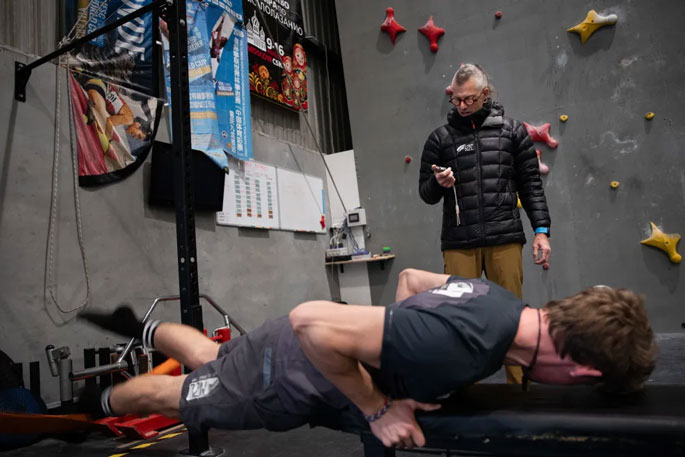 Rob Moore goes through a training drill with speed climber Julian David. Photo: RNZ / Cole Eastham-Farrelly.
Rob Moore goes through a training drill with speed climber Julian David. Photo: RNZ / Cole Eastham-Farrelly.
But Moore says the biggest advantage of the relationship with the government funding agency is gaining access to sports scientists who have taken on the challenge of helping to develop sports-specific strength and conditioning exercises.
"It's made the climbers feel like they are part of this world."
They are already leaving their mark on it. In the HPSNZ gym in Cambridge there's a white board on the wall listing records in various strength and power exercises.
The list is a who's who of rugby stars, netballers, and past and present Olympians.
For 14 years, former sprint cyclist Eddie Dawkins held the record for best standing vertical jump. Last year, his name was scrubbed out and Julian David's was written in his place.
Rapid ascent
Six years ago, Moore cornered one of his counterparts from Japan at an event in Austria and asked him how he had built such a successful programme.
At that point the Japanese were dominating the sport climbing scene, particularly in bouldering. Moore wanted to know what they had done to achieve strong, sustainable success that he might be able to apply back home.
Earlier this year, a visiting coach from Japan contacted Moore to see if she could glean some insights into what is behind New Zealand's sudden rise. It was a full circle moment for the Kiwi coach.
"On the world stage our trajectory has climbed really, really fast," he says.
It started with David's breakthrough victory at the youth world championships in 2023 - a result that saw the 19-year-old, whose father is French, being pursued to switch allegiances to France, where the sport has a large following.
Later that year, both David and Tetzlaff took out the Oceania Championships, qualifying New Zealand a spot in the men's and women's speed climbing at the Olympics.
In the lead-up to the Games the New Zealand pair have both lowered their national and Oceania records several times - including twice in one day at last week's World Cup meeting in Chamonix, France.
There, Tetzlaff set a new mark of 8.40 seconds, while David recorded a new personal best of 5.26.
"We always joke that if we started the programme one year earlier, we would have been breaking world records," Moore says.
"We all have long term visions for how the programme will work and we're still really young on the programme - it's only two and a bit years so it is pretty exciting to see where we have got to."
David believes the rapid ascent of the New Zealand speed climbers can be put squarely down to Moore's energy and passion.
"It's incredible. Like he was the one with the idea, you know, he's been doing this for so long before I was born. He's had this passion, this dream. And, well, he's freaking made it happen, hasn't he?"

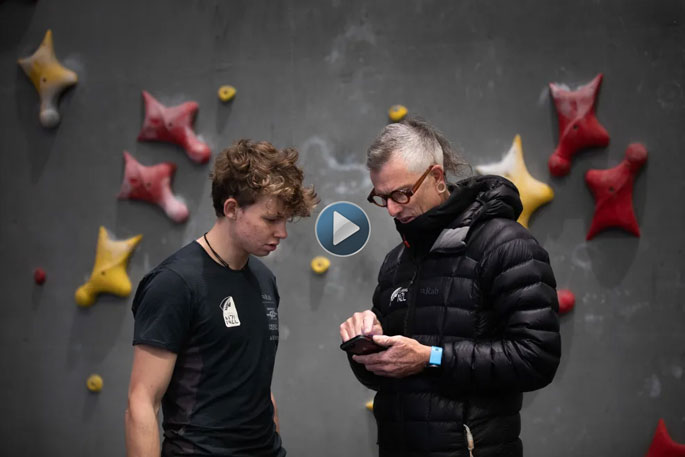

0 comments
Leave a Comment
You must be logged in to make a comment.